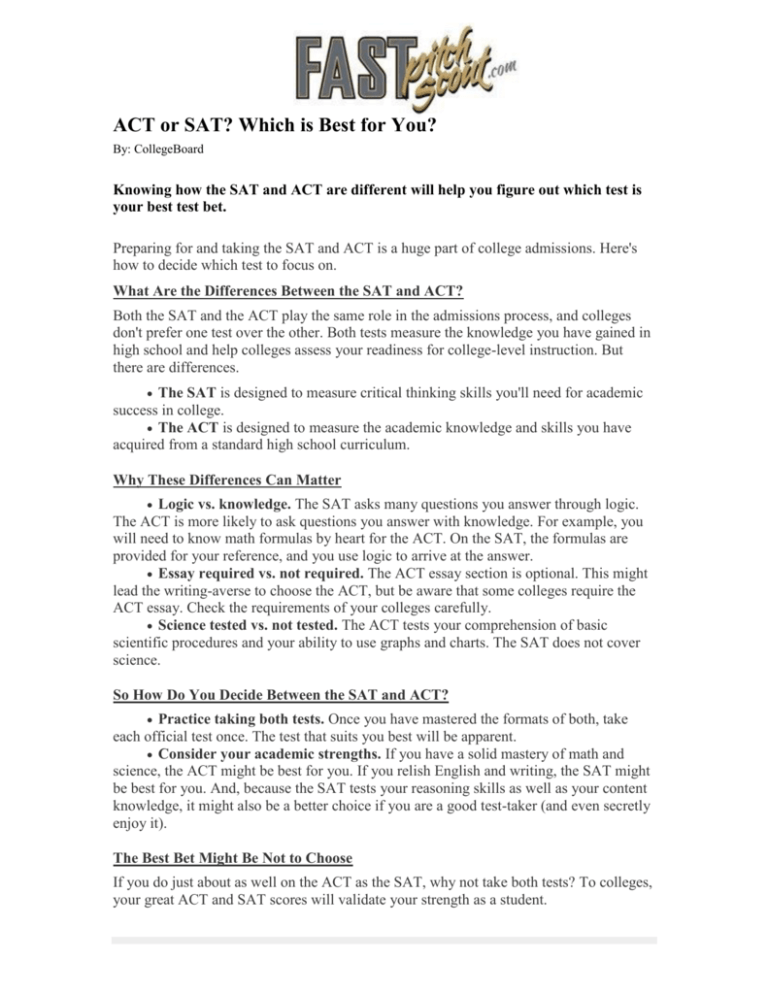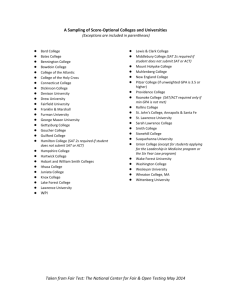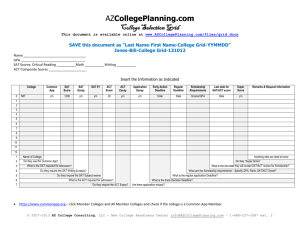ACT or SAT - FastPitch Scout
advertisement

ACT or SAT? Which is Best for You? By: CollegeBoard Knowing how the SAT and ACT are different will help you figure out which test is your best test bet. Preparing for and taking the SAT and ACT is a huge part of college admissions. Here's how to decide which test to focus on. What Are the Differences Between the SAT and ACT? Both the SAT and the ACT play the same role in the admissions process, and colleges don't prefer one test over the other. Both tests measure the knowledge you have gained in high school and help colleges assess your readiness for college-level instruction. But there are differences. The SAT is designed to measure critical thinking skills you'll need for academic success in college. The ACT is designed to measure the academic knowledge and skills you have acquired from a standard high school curriculum. Why These Differences Can Matter Logic vs. knowledge. The SAT asks many questions you answer through logic. The ACT is more likely to ask questions you answer with knowledge. For example, you will need to know math formulas by heart for the ACT. On the SAT, the formulas are provided for your reference, and you use logic to arrive at the answer. Essay required vs. not required. The ACT essay section is optional. This might lead the writing-averse to choose the ACT, but be aware that some colleges require the ACT essay. Check the requirements of your colleges carefully. Science tested vs. not tested. The ACT tests your comprehension of basic scientific procedures and your ability to use graphs and charts. The SAT does not cover science. So How Do You Decide Between the SAT and ACT? Practice taking both tests. Once you have mastered the formats of both, take each official test once. The test that suits you best will be apparent. Consider your academic strengths. If you have a solid mastery of math and science, the ACT might be best for you. If you relish English and writing, the SAT might be best for you. And, because the SAT tests your reasoning skills as well as your content knowledge, it might also be a better choice if you are a good test-taker (and even secretly enjoy it). The Best Bet Might Be Not to Choose If you do just about as well on the ACT as the SAT, why not take both tests? To colleges, your great ACT and SAT scores will validate your strength as a student. Overview: Current SAT vs. Redesigned SAT 2016 This high-level comparison between the current SAT and the redesigned SAT highlights major design features of the two tests. The first table provides a comparison of the major features of the current SAT and redesigned SAT. The second table provides a comparison by test, including the number of items and testing time. It is important to note that while the information in these tables represents our best understanding of the nature and features of the redesigned SAT, some specific elements, such as timing, length, and reported scores, are subject to revision based on the ongoing research process that guides the redesign. Major Features Comparison of the Major Features: Current SAT vs. Redesigned SAT Category Current SAT Total Testing 3 hours and 45 minutes Time* Redesigned SAT 3 hours (plus 50 minutes for the Essay [optional]) *Redesigned SAT testing time subject to research Components1. 2. 3. 4. Important Features Essay Critical Reading 1. Evidence-Based Reading and Writing Writing Reading Test Mathematics Writing and Language Essay Test 2. Math 3. Essay (optional) Emphasis on general reasoning skills Emphasis on vocabulary, often in limited contexts Complex scoring (a point for a correct answer and a deduction for an incorrect answer; blank responses have no impact on scores) Continued emphasis on reasoning alongside a clearer, stronger focus on the knowledge, skills, and understandings most important for college and career readiness and success Greater emphasis on the meaning of words in extended contexts and on how word choice shapes meaning, tone, and impact Rights-only scoring (a point for a correct answer but no deduction for an incorrect answer; blank responses have no impact on scores) Required and given at the beginning of Optional and given at the end of the SAT; postsecondary institutions determine whether they will require Score Reporting* *Redesigned SAT scores subject to research Subscore Reporting the SAT 25 minutes to write the essay Tests writing skill; students take a position on a presented issue Scale ranging from 600 to 2400 Scale ranging from 200 to 800 for Critical Reading; 200 to 800 for Mathematics; 200 to 800 for Writing Essay results scaled to multiple-choice Writing None the Essay for admission 50 minutes to write the essay Tests reading, analysis, and writing skills; students produce a written analysis of a provided source text Scale ranging from 400 to 1600 Scale ranging from 200 to 800 for Evidence-Based Reading and Writing; 200 to 800 for Math; 2 to 8 on each of three traits for Essay Essay results reported separately Sub scores for every test, providing added insight for students, parents, admission officers, educators, and counselors Comparison of Test Length and Timing: Current SAT vs. Redesigned SAT Current SAT Redesigned SAT Time Allotted (minutes) Number of Question/ Tasks Component Time Allotted (minutes) Number of Questions/ Tasks Critical Reading 70 67 Reading 65 52 Writing 60 49 Writing and Language 35 44 Essay 25 1 Essay (optional) 50 1 54 Math 80 58 171 Total 180 154 (230 (155 with with Essay) Essay) Component Mathematics 70 Total 225







